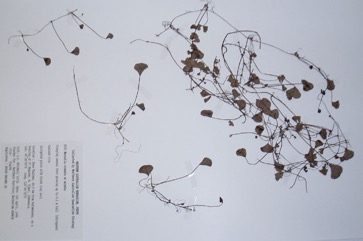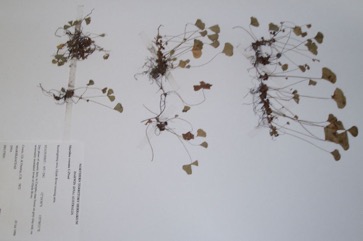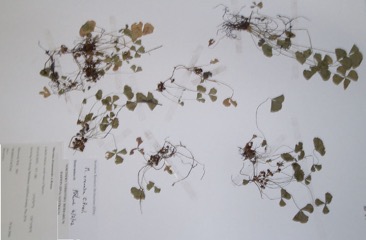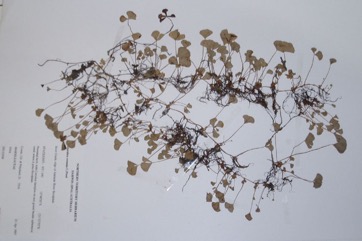Notched Nardoo, Water clover

A tropical plant. It can grow in water with the fronds floating but also with erect fronds on the edge of swamps. It needs full sunlight. It is damaged by frosts. It grows in rice fields. In Papua New Guinea it grows from sea level to about 50 m altitude. It tends to be in areas with a prolonged dry season.
Also known as:
Chawng-khu-pei-du, Pak wan, Phak waen, Semanggi, Tapak itek, Wean
Edible Portion
- Leaves, Fronds
Where does Notched Nardoo grow?
Found in: Africa, Asia, Australia, East Africa, Indochina, Indonesia, Laos, Madagascar, Pacific, Papua New Guinea, PNG, Philippines, SE Asia, Thailand, Vietnam
Notes: Plants are rich in Vitamin A. There are about 50-60 Marsilea species.
Status: It is sold in markets in Thailand. Not known to be used as a food in Papua New Guinea.
Growing Notched Nardoo, Water clover
Cultivation: Plants are grown by dividing the clump.
Edible Uses: The young leaves are eaten as a raw or steamed vegetable dipped in hot sauces.
Nutrition Info
per 100g edible portion| Edible Part | Energy (kcal) | Protein (g) | Iron (mg) | Vitamin A (ug) | Vitamin c (mg) | Zinc (mg) | % Water |
|---|---|---|---|---|---|---|---|
| Leaves | 27 | 1 | - | - | - | - | 93 |
Notched Nardoo, Water clover Photos




References
Amoroso, V., et al, 2017, Indigenous edible ferns in southern Philippines: Utilization and conservation. China_Botanical Congress. p 3
Andrews, S.B., 1990, Ferns of Queensland. A handbook to the ferns and fern allies. Queensland DPI p 240
Anderson, E. F., 1993, Plants and people of the Golden Triangle. Dioscorides Press. p 215
Burkill, I.H., 1966, A Dictionary of the Economic Products of the Malay Peninsula. Ministry of Agriculture and Cooperatives, Kuala Lumpur, Malaysia. Vol 2 (I-Z) p 1450
Chin, W.Y., 1998, Ferns in the Tropics. Kangaroo. p 139 (Photo)
Cruz-Garcia, G. S., & Price, L. L., 2011, Ethnobotanical investigation of 'wild' food plants used by rice farmers in Kalasin, Northeast Thailand. Journal of Ethnobiology and Ethnomedicine 7:33
Elliot, W.R., & Jones, D.L., 1993, Encyclopedia of Australian Plants suitable for cultivation. Vol 6. Lothian. p 308
Food Composition Tables for use in East Asia FAO http://www.fao.org/infoods/directory No. 795
Jacquat, C., 1990, Plants from the Markets of Thailand. D.K. Book House p 33
Jiwajinda, S., et al, 2002, Suppressive Effects of Edible Thai Plants on Superoxide and Nitric Oxide Generation. Asian Pacific Journal of Cancer Prevention, Vol 3, 2002
Kuhnlein, H. V., et al, 2009, Indigenous Peoples' food systems. FAO Rome p 172
Leach, G.J., Osborne, P.L., 1985, Freshwater Plants of Papua New Guinea. UPNG Press, p 49 (Drawing)
Lembogi Biologi Nasional, 1980, Sayur-sayuran. Balai Pustaka, Jakarta. p 96
Luczaj, L., et al, 2021, Wild food plants and fungi sold in the markets of Luang Prabang, Lao PDR. Journal of Ethnobiology and Ethnomedicine (2021) 17:6
Martin, F.W. & Ruberte, R.M., 1979, Edible Leaves of the Tropics. Antillian College Press, Mayaguez, Puerto Rico. p 204
Ochse, J.J. et al, 1931, Vegetables of the Dutch East Indies. Asher reprint. p 481
Pham-Hoang Ho, 1999, An Illustrated Flora of Vietnam. Nha Xuat Ban Tre. p 211
Piggott, A. G. 1988, Ferns of Malaysia in Colour. Tropical press, Malaysia. p 442
Romanowski, N., 2007, Edible Water Gardens. Hyland House. p 98
Setalaphruk, C. & Price, L. L., 2007, Children's traditional ecological knowledge of wild food resources: a case study in a rural village in Northeast Thailand. Journal of Ethnobiology and Ethnomedicine. 3:33
Somnasang, P., et al, 1998, Indigenous knowledge of wild food hunting and gathering in north-east Thailand. Food and Nutrition Bulletin vol. 19 No. 4 pp 359ff
Srichaiwong, P., et al, 2014, A Study of the Biodiversity of Natural Food Production to Support Community Upstream of Chi Basin, Thailand. Asian Social Science 10 (2):
Sukenti, K., et al, 2016, Ethnobotanical study on local cuisine of the Sasak tribe in Lombok Island, Indonesia. Journal of Ethnic Foods. 3 (2016) 189-200 p 198
Wheeler, J.R.(ed.), 1992, Flora of the Kimberley Region. CALM, Western Australian Herbarium, p 49